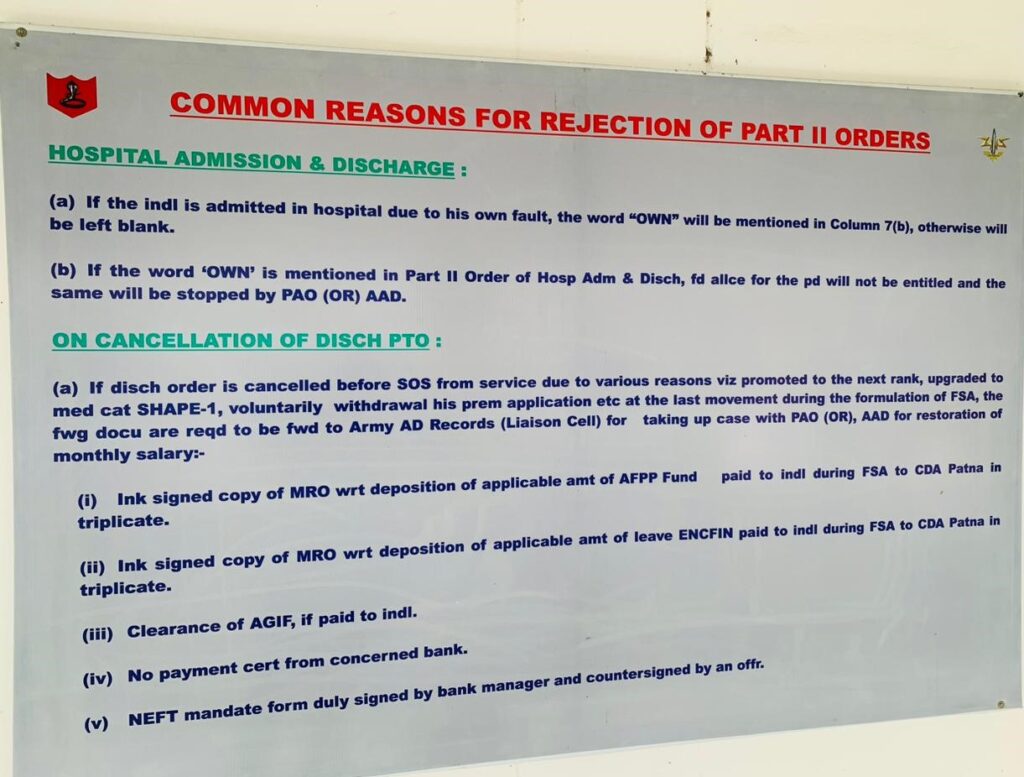In the administrative operations of the military, accuracy and adherence to procedural standards are crucial. One of the key administrative processes is the issuance of Part II Orders, which record various personnel-related activities such as hospital admissions, discharges, promotions, and transfers. However, there are instances where these orders get rejected due to various reasons. This article delves into some common reasons for rejection of Part II Orders, particularly focusing on hospital admissions, discharges, and cancellations of discharge Permanent Transfer Orders (PTO).
Hospital Admission and Discharge
- Admission Due to Own Fault: One common reason for the rejection of Part II Orders is when an individual is admitted to the hospital due to their own fault. In such cases, the word “OWN” is explicitly mentioned in Column 7(b) of the order. This specific notation indicates that the individual’s hospital admission was a result of their own actions, and not due to service-related injuries or illnesses. If this is not properly documented, the order may be left blank, leading to its rejection.
- Mention of ‘OWN’ in Hospital Admission and Discharge: Similarly, if the word “OWN” appears in the Part II Order related to hospital admission and discharge, the individual will not be entitled to certain allowances for the period of their hospital stay. This can be a significant factor as the Pay and Accounts Office (PAO) or the Army Accounts Department (AAD) will stop any related payments. Ensuring the correct usage and placement of the term “OWN” is thus critical in the documentation process.
Cancellation of Discharge PTO
- Various Reasons for Cancellation: The cancellation of discharge PTOs can occur due to multiple reasons, including:
- Promotion to the next rank
- Upgradation to medical category SHAPE-1
- Voluntary withdrawal of pre-mature retirement applications
When any of these situations arise, the formulation of the Final Settlement Account (FSA) needs to be meticulously handled. Failure to do so can result in the rejection of the Part II Order. The following documents must be forwarded to the Army AD Records (Liaison Cell) for taking up the case with the PAO (OR) and AAD for the restoration of the monthly salary:
- Required Documentation: (i) Ink Signed Copy of MRO: The Military Receivable Order (MRO) related to the deposition of the applicable amount of Armed Forces Provident Fund (AFPP) must be provided. This document should be signed in ink and submitted in triplicate to the Controller of Defence Accounts (CDA) in Patna.
(ii) MRO for Leave Encashment: Another ink-signed copy of the MRO is required for the deposition of the applicable amount of leave encashment (ENC FIN). This, too, needs to be submitted in triplicate to the CDA Patna.
(iii) Clearance of AGIF: If the Army Group Insurance Fund (AGIF) has been paid to the individual, clearance documentation for this must be included.
(iv) No Payment Certificate: A no payment certificate from the concerned bank is necessary to ensure that there are no pending payments that could complicate the settlement process.
(v) NEFT Mandate Form: The National Electronic Funds Transfer (NEFT) mandate form must be duly signed by the bank manager and countersigned by an officer. This ensures that the funds are transferred to the correct account without any hitches.
Importance of Accurate Documentation
Accurate and thorough documentation is the backbone of military administration. The rejection of Part II Orders not only delays the processes but also affects the individuals involved, sometimes leading to financial complications. Here are a few reasons why meticulous documentation is indispensable:
- Financial Implications: Errors in documentation can lead to financial discrepancies, affecting allowances and entitlements of the personnel. In cases where the term “OWN” is not correctly noted, individuals may lose out on allowances they are otherwise entitled to.
- Administrative Efficiency: Correct documentation ensures smooth administrative operations. Rejections mean additional paperwork, re-submissions, and time delays, which can be avoided with accurate initial submissions.
- Personnel Morale: Frequent rejections of Part II Orders can demoralize the personnel. Knowing that their administrative issues are being handled efficiently contributes to their overall morale and trust in the system.
Steps to Ensure Proper Documentation
To avoid the common pitfalls that lead to the rejection of Part II Orders, the following steps can be implemented:
- Training and Awareness: Regular training sessions for administrative personnel on the correct procedures and documentation requirements can minimize errors. Awareness campaigns about the importance of accurate entries, especially concerning terms like “OWN,” can be beneficial.
- Double-Check System: Implementing a double-check system where another officer reviews the Part II Orders before submission can catch errors early. This secondary review can identify and correct potential issues that could lead to rejections.
- Use of Checklists: Developing and using checklists for required documents and procedures can help ensure nothing is missed. These checklists can serve as a guide for personnel handling the documentation.
- Regular Audits: Conducting regular audits of the documentation process can identify recurring issues and areas for improvement. These audits can be used to refine and streamline procedures.
Conclusion
The rejection of Part II Orders can stem from various reasons, primarily revolving around inaccuracies in documentation related to hospital admissions, discharges, and cancellations of discharge PTOs. By understanding these common reasons and implementing strict documentation protocols, the military can enhance administrative efficiency, ensure financial accuracy, and maintain the morale of its personnel. Accurate documentation is not just a procedural necessity but a cornerstone of effective military administration.




